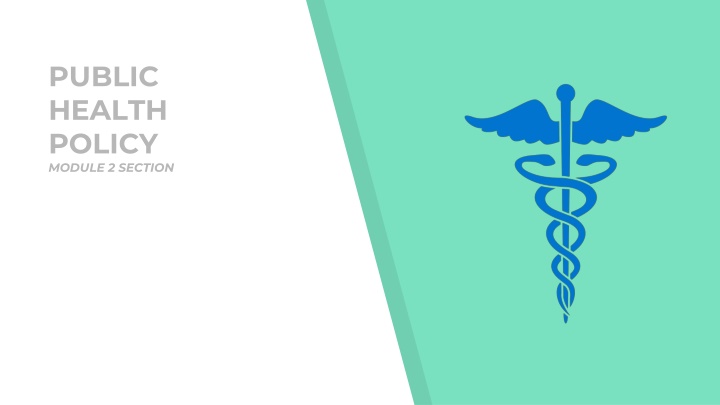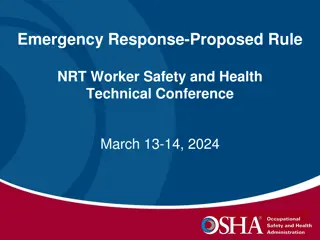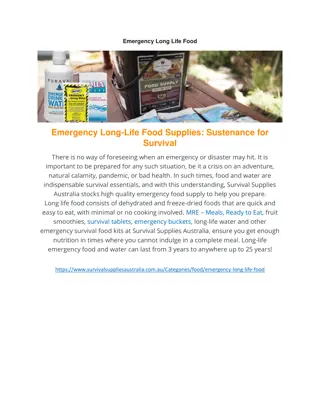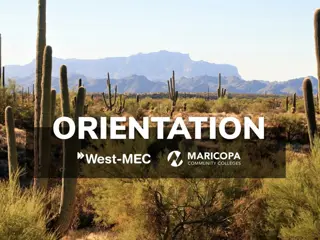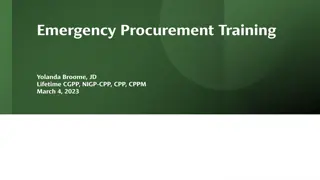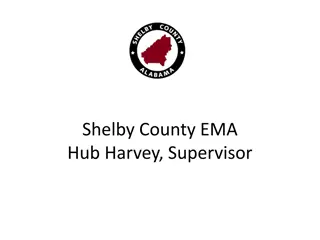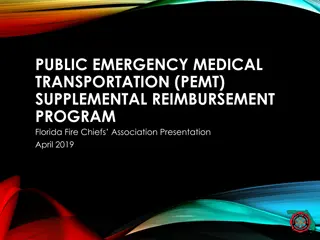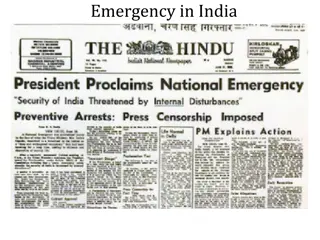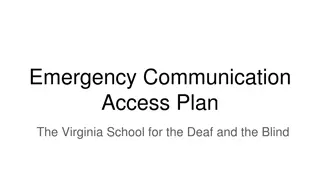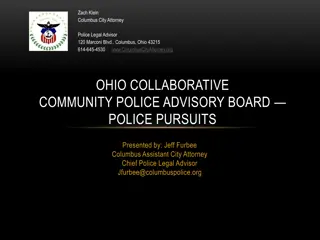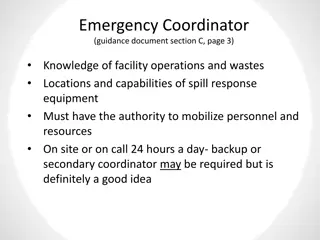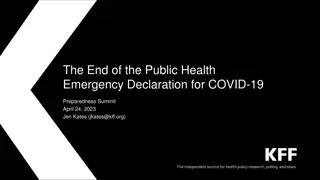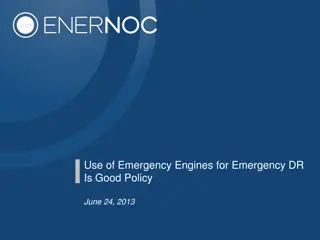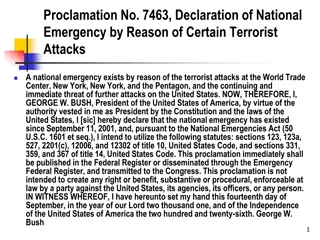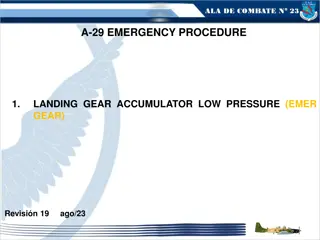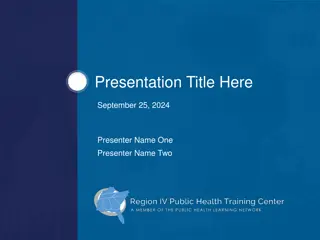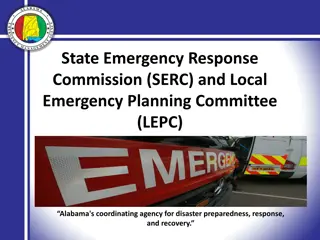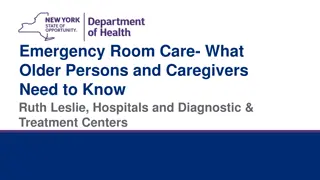Emergency Support Function #8 and Public Health Policy Insights
This content delves into the critical role of ESF #8 in providing public health and medical services during emergencies. It highlights the key aspects of federal support mechanisms, the Pandemic and All-Hazards Preparedness Reauthorization Act, and the National Health Security Strategy, focusing on enhancing national readiness and response capabilities. Additionally, it covers the National Incident Management System, emphasizing resource management, command, coordination, and communication strategies.
Uploaded on Mar 13, 2025 | 0 Views
Download Presentation

Please find below an Image/Link to download the presentation.
The content on the website is provided AS IS for your information and personal use only. It may not be sold, licensed, or shared on other websites without obtaining consent from the author.If you encounter any issues during the download, it is possible that the publisher has removed the file from their server.
You are allowed to download the files provided on this website for personal or commercial use, subject to the condition that they are used lawfully. All files are the property of their respective owners.
The content on the website is provided AS IS for your information and personal use only. It may not be sold, licensed, or shared on other websites without obtaining consent from the author.
E N D
Presentation Transcript
PUBLIC HEALTH POLICY MODULE 2 SECTION
EMERGENCY SUPPORT FUNCTION #8 ESF#8 refers to our Public Health and Medical Services. This function directly correlates with federal support mechanisms and their ability to provide both domestic and international assistance (FEMA, 2016, p.8-1). KEY POINTS SCOPE The planning and coordination needed to carry out federal healthcare delivery relies on the concepts of ESF#8. This includes the protection of core functional areas like patient care and mass fatality management. CORE CAPABILITIES This includes any capabilities directly related to the public health sector such as Transportation, Supply Chain Logistics, and Public Warning Systems. THE ROLE OF FEDERAL AGENCIES ESF#8 states that the Department of Health and Human Services is primarily tasked with taking action against public health emergencies. The Department of Defense and Department of Homeland Security also play major supporting roles. (FEMA, 2016)
PANDEMIC AND ALL-HAZARDS PREPAREDNESS REAUTHORIZATION ACT A law meant to reauthorize certain programs under the Public Health Service Act and the Federal Food, Drug, and Cosmetic Act with respect to public health security and all-hazards preparedness , ultimately bolstering the Department of Health and Human Services (DHHS, 2013). KEY POINTS RELATED LEGISLATION This law also served as an amendment to the Public Health Service Act, by giving state governments more flexibility for preparedness measures. The Project BioShield Act also provided funding for these preparations. RELATED PROGRAMS Hospital Preparedness Program: promotes public health readiness by funding medical supply stockpiles and other resources for hospitals. Public Health Emergency Preparedness Cooperative Agreement: A collective formed by SLTT leaders to fund local public health departments. (DHHS, 2013)
NATIONAL HEALTH SECURITY STRATEGY Provides a vision to strengthen our nation s ability to prevent, detect, assess, prepare for, mitigate, respond to, and recover from disasters... It describes strategies to improve readiness and adapt operational capabilities to address new and evolving threats. (DHHS, 2021). KEY POINTS OBJECTIVE 1 To focus on the Whole-of-Government approach by forming better partnerships between federal and SLTT levels of government, in addition to international stakeholders. OBJECTIVE 2 To develop better defenses against Pandemic Infectious Diseases and CBRN Threats. This can be achieved by expanding public health resource capacity. OBJECTIVE 3 To effectively utilize the capabilities of the Private Sector by incentivizing stakeholders and improving medical supply chains. (DHHS, 2021)
NATIONAL INCIDENT MANAGEMENT SYSTEM It is a system designed to guide all levels of government and other relevant stakeholders during any large scale incidents by providing authorities with shared vocabulary, systems, and processes (FEMA, 2017, p.1). KEY POINTS RESOURCE MANAGEMENT Relates to the mechanisms used to manage physical resources, and the supply chain capabilities needed to distribute them efficiently. COMMAND AND COORDINATION Lays out an ideal framework for the organizational structures needed to respond to disasters. Also builds upon interactions between separate structures. COMMUNICATIONS AND INFORMATION MANAGEMENT Describes the methods that incident managers can use to guide their decision making processes and the way they communicate gathered data. (FEMA, 2017)
DOD DIRECTIVE 3025.1 This publication from the Department of Defense describes the protocols used by military leaders when Defense Support Of Civil Authorities (DSCA) operations are enacted (DOD, 2018). KEY POINTS ALL HAZARDS RESPONSE When local capabilities prove to be insufficient, the Stafford Act can be invoked in order to declare a state of emergency. Military forces can then be deployed to aid in disaster relief efforts. SUPPORT TO LAW ENFORCEMENT When requested, DSCA operations can be activated to assist local law enforcement with anything from antiterrorism operations to border security details. OTHER RELEVANT SCENARIOS Military forces can be deployed for many other reasons under DSCA. This can include providing security at certain political events, to assist the Secret Service, and event provide support to postal services. (DOD, 2018)
ROBERT T. STAFFORD DISASTER RELIEF AND EMERGENCY ASSISTANCE ACT This law designates accountable authority for most forms of federal disaster response events. It is especially important for the operations of the Federal Emergency Management Agency (FEMA, 2021). KEY POINTS DISASTER PREPAREDNESS PROGRAMS This section of the Stafford Act lays out grant plans for State governments and federal organizations to ensure pre- disaster readiness. It also discusses interagency task forces and resources the mitigation measures needed for infrastructure damage. DISASTER AND EMERGENCY RESPONSE PROGRAMS Establishes guidelines for the roles of Federal Coordinating Officers and Emergency Support Teams. This section also discusses reimbursement measures for government agencies and other forms of disaster assistance, (FEMA, 2021)
CDC. (2021). Public Health Emergency Preparedness (PHEP) Cooperative Agreement. https://www.cdc.gov/cpr/readiness/phep.htm DHHS. (2013). Pandemic and All-Hazards Preparedness Reauthorization Act. Retrieved from https://www.phe.gov/Preparedness/legal/pahpa/Pages/pahpra.aspx DHHS. (2021). National Health Security Strategy. Retrieved from https://www.phe.gov/Preparedness/planning/authority/nhss/Pages/default.aspx DOD. (2018). DoD Directive 3025.1: Military Support to Civil Authorities (MSCA). DOD. https://fas.org/irp/doddir/dod/jp3_28.pdf#page=1 FEMA. (2016). Emergency Support Function (ESF) #8, National Response Framework. https://www.fema.gov/sites/default/files/2020-07/fema_ESF_8_Public-Health-Medical.pdf FEMA. (2017). National incident management system. FEMA. MODULE 2 SOURCES https://www.fema.gov/sites/default/files/2020-07/fema_nims_doctrine-2017.pdf FEMA. (2021). Stafford Act. FEMA. https://www.fema.gov/disaster/stafford-act
MAJOR PUBLIC HEALTH ROLES MODULE 1 SECTION By Hannah Leonard EDM 412 - Emergency Healthcare Logistics in Disasters Dr. Christopher Janik July 28, 2021
PUBLIC HEALTH NURSE Public health nursing is the practice of promoting and protecting the health of populations using knowledge from nursing, social, and public health sciences. (APHN, 2014, p.5). The Role Of Phn Throughout The Disaster Cycle PREPAREDNESS PHN workers are expected to perform threat assessments prior to emergencies, while also creating develop care plans to tackle perceived obstacles, RESPONSE Triage Algorithms are developed from data collected by PHN workers and similar support personnel. This helps to support the ongoing response planning needed for the National Incident Management System. RECOVERY Evaluations for the long term impact of disasters are supported by PHN data. This also assists in the delivery of rapid needs assessments. (APHN, 2014, p.7-8)
ENVIRONMENTAL HEALTH SPECIALIST Environmental health professionals: Find response activities by environmental health mission to help you fulfill your important roles in all-hazards emergency preparedness, response, recovery, and mitigation. (CDC, 2018). HOW EHS HELP TO PROTECT THE FOUR MAJOR AREAS SAFE WATER EHS workers can monitor a water supplies for substances like Legionella bacteria, which cause over half of all waterborne disease outbreaks. FOOD SAFETY Foodborne outbreaks are prevented through proper environmental health practices. This allows restaurants and other institutions to be regulated by FDA standards. ENVIRONMENTAL HEALTH PRACTICE By strategically placing EHS workers throughout critical areas in a community, authorities can improve health standards overall VESSEL SANITATION PROGRAM Routine sanitation inspection are performed on cruise ships and other maritime vessels to control the potential for other disease outbreaks. (CDC, 2018).
EPIDEMIOLOGIST Epidemiology assesses the short- and long-term adverse health effects of disasters to help guide emergency response and recovery efforts and predict consequences of future disasters. (CDC, 2019). HOW EPIDEMIOLOGIC TOOLS AND RESEARCH ENSURE DISASTER PREPAREDNESS Epidemiologists conduct morbidity and mortality surveillance during disasters in order to keep the public informed on the scope of a health crisis. Based off of the findings of epidemiologists, community leaders can more accurately assess and update their public health methods. Several epidemiological organizations exist to ensure communication throughout the scientific community, such as: The Community Assessment for Public Health Emergency Response (CASPER) The Disaster Epidemiology Community of Practice (DECoP) The National Center for Environmental Health (CDC, 2019)
MENTAL HEALTH PROVIDER Even when immediate danger has passed, the impact can still be felt... When thinking about rebuilding their lives [many] may feel overwhelmed and not know how to begin. Taking those first steps toward recovery can be easier with a little support. (American Red Cross, 2021). THE IMPORTANCE OF MEETING MENTAL HEALTH NEEDS FOLLOWING A DISASTER An individual's ability to recover from a disaster is severely impacted by the state of their physical, psychological, and social characteristics: meaning that mental care can significantly improve recovery. Mental health providers can assist disaster victims with a number of stressors, to include: Dealing with injuries sustained during a disaster. The stress caused by a lack of financial assistance needed to rebuild. The stress of submitting an insurance claims. The trauma caused from seeing others harmed and/or dying. (Aitsi-Selmi, Blanchard, & Murray, 2015, p.34)
MEDICAL RESERVE CORPS The Medical Reserve Corps (MRC) is a national network of volunteers, organized locally to improve the health and safety of their communities. (MRC, 2021) HOW THE MEDICAL RESERVE CORPS WORKS TO SUPPORT PUBLIC HEALTH TYPES OF MRC VOLUNTEERS MRC volunteers include individuals with and without healthcare backgrounds, They can assist in critical roles such as: Blood Clinic Technicians Medical Administrator Public Health Nurse ACTIVITIES SUPPORTED BY MRC VOLUNTEERS MRC volunteers actively run critical public health resources like: Responder Rehabilitation Vaccination Clinics Veterinary Support Centers Medical Surge Facilities (MRC, 2021)
Aitsi-Selmi, Blanchard, & Murray. (2015). The role of public health within the United Nations post-2015 Framework for Disaster Risk Reduction. International Journal of Disaster Risk Science, 6(1) 28 37. Available at Trident Online Library. American Red Cross. (2021). Disaster Mental Health. American Red Cross. https://www.redcross.org/about-us/our-work/disaster-relief/disaster-mental-health.html APHN. (2014). The role of the public health nurse in disaster preparedness, response, and recovery. Association of Public Health Nurses. https://www.naccho.org/uploads/blog/nacchopreparedness/APHN_Role-of-PHN-in-Disaster- PRR_FINALJan14.pdf CDC. (2018). Environmental health services: Emergency and terrorism preparedness for Environmental Health Practitioners. Retrieved from https://www.cdc.gov/nceh/ehs/etp/default.htm CDC. (2019). Disaster Epidemiology & Response. CDC. MODULE 1 SOURCES https://www.cdc.gov/nceh/hsb/disaster/default.htm MRC. (2021). About the Medical Reserve Corps. MRC. https://mrc.hhs.gov/pageViewFldr/About
